Geobiology and Molecular Fossils
Recent News
- IRC Research Ally Prize
- New instruments for high precision land surveying arrive at UCD
- Neoma MC-ICP-MS delivery
- Hook Head Peninsula Fieldtrip
- Next Generations Explorers Award
- Software Agreement with Baker Hughes
- Maeve Boland elected Fellow of the Geological Society of America
- New faculty - Dr Kara English
- New faculty – four Ad Astra Fellows
- Dr Laia Comas-Bru WCRP/GCOS Data Prize
- Mass extinction - learning from the past for the future
- Formation of platinum-group ore deposits & sub-volcanic intrusions
- UCD’s School of Earth Sciences collaboration with Irish-based NGO Self Help Africa (SHA)
- Swampy rainforests in Antarctica dated to the mid-Cretaceous
- Professor Frank McDermott Nature Publication
- The Blue Book Project
- Geology Workshop
- IGA Diamond Jubilee Lecture
- Mt Etna
- Dr William Foster Publication
- Journal of Quaternary Science Publication
- Dr Srikumar Roy Review article
- SGA 2019 Pre-conference Field Trip
- UCD Festival 2019
- Dr Chris Mark awarded SFI Starting Investigator Research Grant
- TOSCA travels to the Mid-Atlantic ridge and discovers an other-wordly landscape
- UCD School of Earth Sciences-led international expedition, TOSCA, sets sail
- Piecing Together the Big Picture on Water and Climate
- Prof John Walsh awarded 2017 RIA Gold Medal
- Assoc Professor Eoghan Holohan Irish Research Council
- 2018
- 2017
- 2016
- PAGES working group SISAL workshop
- Micrometre-scale deformation observations reveal fundamental controls
- Geobiology and Molecular Fossils
- PANTHER Marine Research Expedition
- Renata Barros Foord Pegmatite Symposium in Golden Colorado
- Bardarbunga volcano Iceland
- 3rd to 4th Yr Duties 2016
- Remembering Steve Millan
- Dr Laia Comas Bru AGU2016
Geobiology and Molecular Fossils
Geobiology is the study of the interactions and interrelationships between the physical Earth and biology, especially the ‘unseen’ microbial majority. As a multidisciplinary and highly integrated discipline Geobiology is relatively young, but the types of questions it addresses have been puzzling scientists for generations - How did life arise and diversify on early Earth? How has biology affected global physical and chemical processes throughout Earth’s history and today? What are the major triggers that drive evolution and diversification of life? These questions are some of the most fundamentally important scientific questions that we can hope to answer.
In September, an exciting yet controversial paper in (opens in a new window)Nature reported new physical and chemical evidence for microbial life preserved in the Isua Greenstone Belt, and if correct extends the evidence of life from 3500 Ma to 3700 Ma! The preserved laminated microbial mat structures that accrete to form stromatolites. These rocks, with other reported examples, are the scant remains of extensive shallow marine, carbonate-producing environments from Archean Earth. However, while relatively rare, modern examples such as those in The Bahamas and Turks and Caicos provide an important alternative to understanding life and environments on early Earth. In July, a team of geologists, sedimentologists, microbiologists, geochemists and historians from Caltech, Harvard, MIT, Dartmouth College and UC Berkeley gathered on Little Ambergris Cay in the Turks and Caicos Islands to study some of the best modern analogs for these ancient settings and hotspots for early life. This was funded by the (opens in a new window)Agouron Institute.
.jpg)
Aerial View of Little Ambergris Cay microbial mats and ooiltic sands offshore (Image Credit: Agouron Team)
.jpg)
Shane sampling dense microbial mats on Little Ambergris Cay, Turks & Caicos. (Image Credit: Agouron Team)
MIT and UCD Postdoctoral Fellow, Dr. Shane O’Reilly, was a member of the team. Shane is an organic and isotope biogeochemist, whereby he studies biomolecules and their relict geomolecules, or molecular fossils, in rocks, sediment and soil. These molecules (often called biomarkers) provide a window into the complex molecular world of organic matter. Organic matter is essentially the currency of life and amazingly certain organic molecules can be preserved over tens to hundreds of millions of years. In addition to fueling our global industrial economy, these molecular fossils provide important insight into past life and environments. For more information on molecular fossils, check out (opens in a new window)this recent public lecture Shane gave as part of the (opens in a new window)NOVA PBS (opens in a new window)CaféSci Boston, and the accompanying (opens in a new window)MIT News piece.

The basic principle of organic geochemistry and molecular fossils
Together with microbial mats, non-skeletal carbonate grains called ooids were common on Proterozoic and Archean Earth. These concentrically-layered accretionary grains have puzzled scientists for over a century, but a recent paper published by Shane in the journal (opens in a new window)Geobiology, indicates that the organic matter that is ubiquitous within ooids is derived from microbial biofilms that were once growing on grain surfaces. This has important implications for understanding the role of organic matter and microbes in ooid formation on early Earth. The intricate balance between physical, chemical and biological factors that are involved in ooid formation remain to be fully elucidated, and is one of the principle aims of the Agouron trip to the Turks and Caicos.

The results from microbial mat and ooid studies from the Turks and Caicos trip will be presented in four abstracts at the upcoming (opens in a new window)American Geophysical Union Fall Meeting in San Francisco in mid-December. This will be within a session celebrating ‘(opens in a new window)15 Years of Geobiology’. If the first 15 years of Geobiology are anything to go by, then the next 15 will be worth paying very close attention to!